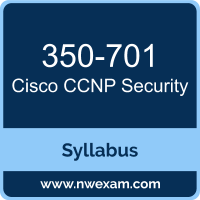 A great way to start the Cisco Certified Specialist Security Core (SCOR) preparation is to begin by properly appreciating the role that syllabus and study guide play in the Cisco 350-701 certification exam. This study guide is an instrument to get you on the same page with Cisco and understand the nature of the Cisco CCNP Security exam.
A great way to start the Cisco Certified Specialist Security Core (SCOR) preparation is to begin by properly appreciating the role that syllabus and study guide play in the Cisco 350-701 certification exam. This study guide is an instrument to get you on the same page with Cisco and understand the nature of the Cisco CCNP Security exam.
Our team of experts has composed this Cisco 350-701 exam preparation guide to provide the overview about Implementing and Operating Cisco Security Core Technologies exam, study material, sample questions, practice exam and ways to interpret the exam objectives to help you assess your readiness for the Cisco SCOR exam by identifying prerequisite areas of knowledge. We recommend you to refer the simulation questions and practice test listed in this guide to determine what type of questions will be asked and the level of difficulty that could be tested in the Cisco CCNP Security certification exam.
Cisco 350-701 Exam Overview:
| Exam Name | Implementing and Operating Cisco Security Core Technologies |
| Exam Number | 350-701 SCOR |
| Exam Price | $400 USD |
| Duration | 120 minutes |
| Number of Questions | 90-110 |
| Passing Score | Variable (750-850 / 1000 Approx.) |
| Recommended Training |
Implementing and Operating Cisco Security Core Technologies | SCOR Implementing and Operating Cisco Security Core Technologies 2.0 Implementing and Operating Cisco Security Core Technologies (SCOR) v2.0 |
| Exam Registration | PEARSON VUE |
| Sample Questions | Cisco 350-701 Sample Questions |
| Practice Exam | Cisco Certified Specialist Security Core Practice Test |
Cisco 350-701 Exam Topics:
| Section | Weight | Objectives |
|---|---|---|
| Security Concepts | 25% |
- Explain common threats against on-premises, hybrid, and cloud environments
- Compare common security vulnerabilities such as software bugs, weak and/or hardcoded passwords, OWASP top ten, missing encryption ciphers, buffer overflow, path traversal, cross-site scripting/forgery |
| Network Security | 20% |
- Compare network security solutions that provide intrusion prevention and firewall capabilities - Describe deployment models of network security solutions and architectures that provide intrusion prevention and firewall capabilities - Describe the components, capabilities, and benefits of NetFlow and Flexible NetFlow records - Configure and verify network infrastructure security methods
- Implement segmentation, access control policies, AVC, URL filtering, malware protection, and intrusion policies
|
| Securing the Cloud | 15% |
- Identify security solutions for cloud environments
- Compare security responsibility for the different cloud service models
- Describe the concept of DevSecOps (CI/CD pipeline, container orchestration, and secure software development) |
| Content Security | 15% |
- Implement traffic redirection and capture methods for web proxy - Describe web proxy identity and authentication including transparent user identification - Compare the components, capabilities, and benefits of on-premises, hybrid, and cloud-based email and web solutions (Cisco Secure Email Gateway, Cisco Secure Email Cloud Gateway, and Cisco Secure Web Appliance) - Configure and verify web and email security deployment methods to protect on-premises, hybrid, and remote users - Configure and verify email security features such as SPAM filtering, antimalware filtering, DLP, blocklisting, and email encryption - Configure and verify Cisco Umbrella Secure Internet Gateway and web security features such as blocklisting, URL filtering, malware scanning, URL categorization, web application filtering, and TLS decryption - Describe the components, capabilities, and benefits of Cisco Umbrella - Configure and verify web security controls on Cisco Umbrella (identities, URL content settings, destination lists, and reporting) |
| Endpoint Protection and Detection | 10% |
- Compare Endpoint Protection Platforms (EPP) and Endpoint Detection & Response (EDR) solutions - Configure endpoint antimalware protection using Cisco Secure Endpoint - Configure and verify outbreak control and quarantines to limit infection - Describe justifications for endpoint-based security - Describe the value of endpoint device management and asset inventory systems such as MDM - Describe the uses and importance of a multifactor authentication (MFA) strategy - Describe endpoint posture assessment solutions to ensure endpoint security - Explain the importance of an endpoint patching strategy |
| Secure Network Access, Visibility, and Enforcement | 15% |
- Describe identity management and secure network access concepts such as guest services, profiling, posture assessment and BYOD - Configure and verify network access control mechanisms such as 802.1X, MAB, WebAuth - Describe network access with CoA - Describe the benefits of device compliance and application control - Explain exfiltration techniques (DNS tunneling, HTTPS, email, FTP/SSH/SCP/SFTP, ICMP, Messenger, IRC, NTP) - Describe the benefits of network telemetry - Describe the components, capabilities, and benefits of these security products and solutions
|
Cisco SCOR Exam Description:
Implementing and Operating Cisco Security Core Technologies v1.1 (SCOR 350-701) is a 120-minute exam associated with the CCNP and CCIE Security Certifications. This exam tests a candidate's knowledge of implementing and operating core security technologies including network security, cloud security, content security, endpoint protection and detection, secure network access, visibility, and enforcements. The course, Implementing and Operating Cisco Security Core Technologies, helps candidates to prepare for this exam.
